Measuring up to learning Chinese
By Lisa Carducci ( China Daily ) Updated: 2010-07-07 09:43:07The response of Chinese on learning their foreign friends are learning Chinese, is almost invariably - "Learning Chinese is very difficult."
This is true, but I don't think foreigners should be discouraged, as learning Chinese can also be easy and fun.

What makes Chinese hard for a learner whose native language uses the Latin alphabet? Chinese characters. In this case, a learner of Cyrillic, Arabic, Tibetan or Hindi faces the same challenge. Chinese is even easier than these languages because pinyin helps a lot.
If the newcomer wants, at least at the beginning, to only speak, and not to read or write the complicated Chinese characters, things become even simpler.
The more languages one knows, the easier it is to acquire a new one. Especially if the learner masters English, Chinese grammar will then appear not only similar but even less complicated than English. There is one exception: the measure words that categorize nouns. But don't we also say "a cup" of tea, "a glass" of wine, "a slice" of bread?
A relative of mine is learning Chinese by herself. I made a list of the common measure words with examples for her to memorize. For example: "When you order a roast duck, you say 'yi zhi kao ya', as a duck is a bird."
She asked me why the cat also uses zhi. Is it classified with the birds because it eats birds?
"No, cat is a feline."
"So I must use zhi for lion and tiger too."
"Well not exactly. You are right for tiger but lion requires tou (head)."
"Didn't you say tou was for farm animals like cow, sheep, pig, horse and donkey?"
"Yes, but not exclusively and not all of them. The horse doesn't share its fellow donkey's bed and requires pi. And the pig is so greedy that it has two measure words: tou or kou (mouth)."
"Gosh, I will never learn! What about a dog?"
I felt a little embarrassed to tell her that dog requires tiao (length) as it belongs to the category of long things, such as pants and skirts, snake and fish.
"I got it!" she said, adding to the list cigarette and pencil.
"Pencil and cigarette no. They need gen. Also hair and rope, you see?"
"What I see is that the concept on which the theory is based is not logical."
I didn't dare to protest, as this was exactly my own conclusion 20 years ago when I was groping in the dark tunnel of learning Chinese. But I tried to encourage her and help her find certain standards.
"Look, what is common between a table, a bed, a postage stamp and a sheet of paper?"

"They are all flat. And quadrangular."
"You are absolutely right. So they share the same measure word: zhang."
At that point she couldn't but laugh. I asked why.
"I think I can add zhang before my brother-in-law's name; he too is square and flat," she said.
After this diversion, she added: "Wait a minute, just before I came here I checked zhang in the dictionary, and I read it was used to categorize mouth, bow, and fishing net! Flat and square, hey? Are we talking about the same zhang? The one that is also a very popular family name?"
"Exactly."
"Maybe it's better not to try to understand and just learn as it is."
"Don't you find this fun to learn? Measure words are what I liked best when I started studying Chinese. They make Chinese special! All the rest is so predictable."
|
|
|
|
|
|
|
|


























 Raymond Zhou:
Raymond Zhou: Pauline D Loh:
Pauline D Loh: Hot Pot
Hot Pot Eco China
Eco China China Dream
China Dream China Face
China Face






